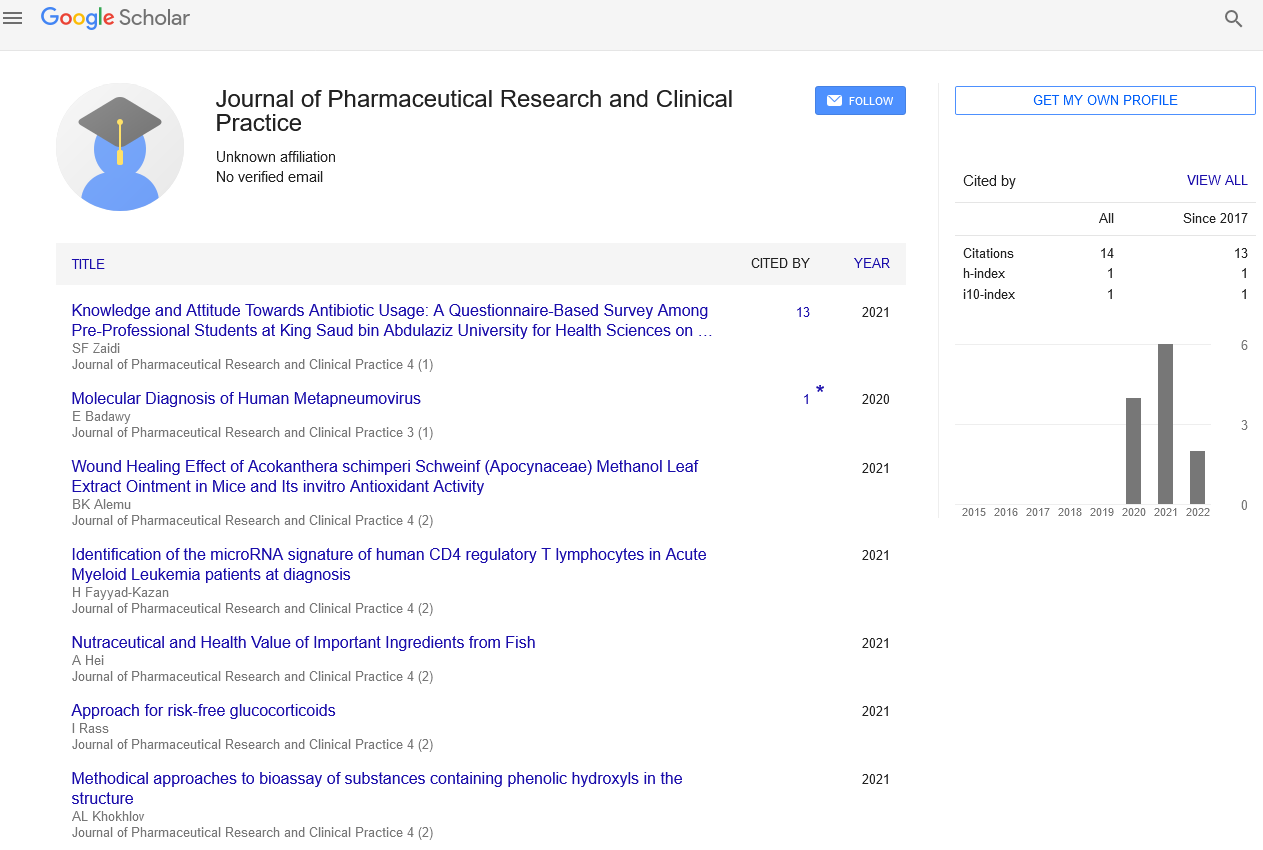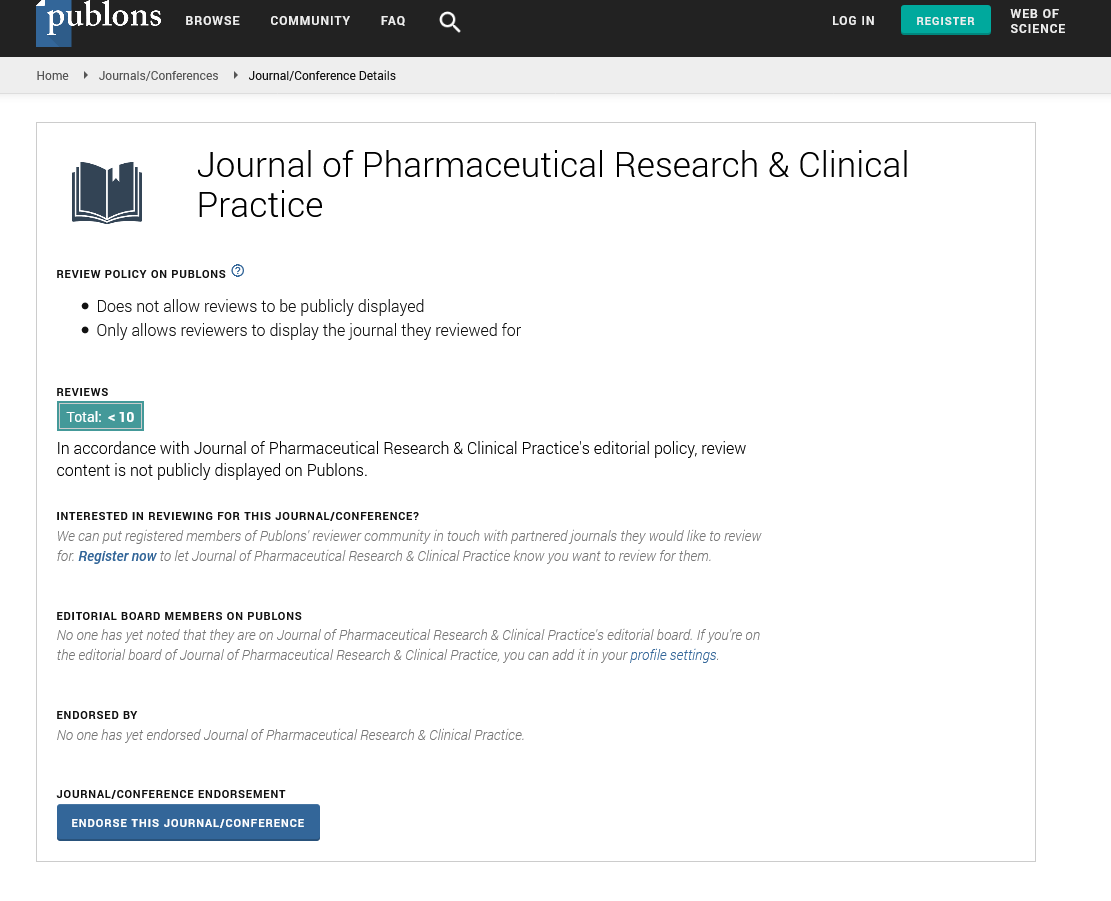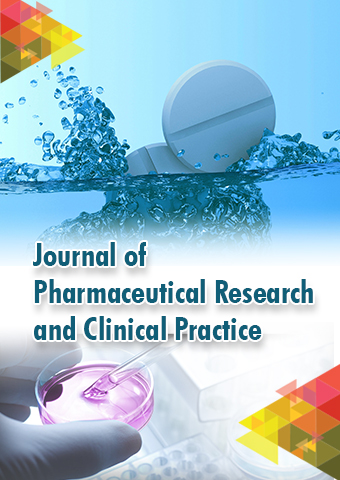Editorial - Journal of Pharmaceutical Research and Clinical Practice (2023) Volume 6, Issue 3
Drug Metabolism: Understanding the Fate of Medications in the Body
Jacklin Mark*
Department of clinical practice, United Kingdom
Department of clinical practice, United Kingdom
E-mail: mark_jacklin@gmail.com
Received: 02-June-2023, Manuscript No. jprcp-23-103114; Editor assigned: 05-Jun-2023, PreQC No. jprcp-23- 103114(PQ); Reviewed: 19-Jun- 2023, QC No. jprcp-23-103114; Revised: 23-Jun-2023, Manuscript No. jprcp-23-103114 (R); Published: 30-Jun-2023; DOI: 10.37532/ jprcp.2023.6(3).46-49
Abstract
Drug metabolism is a vital process that influences the fate of medications within the human body. It involves the enzymatic transformation of drugs into metabolites, which are more easily eliminated from the body. This process primarily occurs in the liver but also involves other organs. Drug metabolism serves various purposes, including drug inactivation, activation of prodrugs, generation of pharmacologically active metabolites, and accounting for individual variability. The mechanisms of drug metabolism encompass phase I and phase II reactions, involving enzymatic modifications and conjugation processes. Factors such as genetic variations, drug-drug interactions, age, and underlying medical conditions can affect drug metabolism. Understanding drug metabolism has significant clinical implications, including drug development, personalized medicine, and ensuring drug safety. Ongoing research in this field continues to enhance our understanding of drug metabolism, leading to improved healthcare outcomes.
Keywords
Drug metabolism • Medications • Fate • Enzymatic transformation • Liver
Introduction
When we consume medications to alleviate symptoms or treat illnesses, have you ever wondered what happens to these drugs once they enter our bodies? How are they processed, transformed, and eventually eliminated? The answers lie within the intricate process known as drug metabolism [1]. Drug metabolism plays a crucial role in determining the fate of medications within the human body, influencing their efficacy, safety, and overall therapeutic outcomes. Drug metabolism refers to the series of biochemical reactions that occur within the body to modify drugs or xenobiotic (foreign substances). These reactions primarily take place in the liver, although other organs such as the kidneys, lungs, and intestines also contribute to the process [2]. By undergoing enzymatic modifications, drugs are transformed into metabolites that can be more readily eliminated from the body through various excretory pathways. Understanding drug metabolism is of utmost importance in the field of healthcare. Firstly, drug metabolism aids in the inactivation and elimination of drugs from the body. This prevents drugs from accumulating to toxic levels and helps maintain the body’s internal balance and homeostasis [3]. Additionally, certain drugs are administered in an inactive form and require metabolism to become active within the body. This activation process allows for targeted drug delivery and enhanced therapeutic efficacy. Moreover, drug metabolism generates metabolites that can exhibit pharmacological activity distinct from the parent drug. These metabolites may contribute to either the desired therapeutic effects or potential adverse reactions. Therefore, studying drug metabolism not only sheds light on the beneficial aspects of medication but also alerts healthcare professionals to potential risks and side effects [4]. Another critical aspect of drug metabolism lies in the individual variability that exists among patients. Factors such as genetic variations, age, sex, and the presence of other medications or underlying medical conditions can significantly influence the metabolism of drugs. Understanding these variations is essential for the advancement of personalized medicine, where treatments can be tailored to suit individual patients based on their unique metabolic profiles. By considering these factors, healthcare providers can optimize drug dosages, minimize adverse reactions, and maximize therapeutic outcomes [5]. In this article, we aim to provide an overview of drug metabolism, its mechanisms, and its significance in healthcare. By delving into the intricate processes of phase I and phase II reactions, the factors influencing drug metabolism, and its clinical implications, we hope to shed light on the vital role drug metabolism plays in determining the fate of medications within the human body [6]. Through continued research and understanding, advancements in drug development, personalized medicine, and patient safety can be achieved, ultimately leading to improved healthcare outcomes for individuals worldwide.
Material and Methods
What is drug metabolism?
Drug metabolism refers to the biochemical modification of drugs or xenobiotics (foreign substances) in the body. It involves a series of enzymatic reactions that convert drugs into metabolites, which are more easily eliminated from the body [7]. Drug metabolism primarily occurs in the liver, although other organs like the kidneys, lungs, and intestines also contribute to the process.
Importance of drug metabolism
Drug metabolism serves several essential purposes:
Inactivation of drugs: The primary function of drug metabolism is to deactivate and eliminate drugs from the body. This ensures that drugs do not accumulate to toxic levels and helps maintain homeostasis.
Activation of prodrugs: Some drugs are administered in an inactive form and require metabolism to become active. This conversion allows for targeted drug delivery and improved therapeutic efficacy.
Generation of metabolites: Drug metabolism produces various metabolites, some of which may possess pharmacological activity distinct from the parent drug [8]. These metabolites can contribute to the drug’s therapeutic or adverse effects.
Individual variability: Drug metabolism can vary between individuals due to genetic factors, age, sex, and the presence of other medications or underlying medical conditions. Understanding these variations is crucial for personalized medicine and determining appropriate drug dosages.
Mechanisms of drug metabolism
There are two main phases of drug metabolism:
Phase (i) reactions: Phase I reactions involve the introduction or exposure of functional groups (e.g., hydroxyl, amino, or carboxyl groups) on the drug molecule. The most common Phase I reactions include oxidation, reduction, and hydrolysis [9]. Cytochrome P450 (CYP) enzymes, located in the liver, are the primary catalysts for Phase I reactions. These enzymes play a significant role in drug-drug interactions and individual variations in drug response.
Phase (ii) reactions: Phase II reactions involve the conjugation of drugs or their metabolites with endogenous compounds, such as glucuronic acid, sulfate, or amino acids. This conjugation process increases the water solubility of the drug, facilitating its elimination. Common Phase II reactions include glucuronidation, sulfation, acetylation, and methylation [10]. Enzymes such as UDP-glucuronosyltransferases (UGTs) and sulfotransferases (SULTs) mediate Phase II reactions.
Factors affecting drug metabolism
Several factors can influence drug metabolism:
Genetic factors: Genetic polymorphisms in drug-metabolizing enzymes can significantly impact drug metabolism. These genetic variations can lead to differences in drug efficacy, toxicity, and adverse reactions among individuals.
Drug-drug interactions: Some drugs can interact with drug-metabolizing enzymes, either inhibiting or inducing their activity. These interactions can alter the metabolism of other drugs, leading to potential therapeutic failure or increased toxicity.
Age: Drug metabolism can vary with age. In general, the metabolic capacity is lower in newborns and young children, gradually increasing to reach its peak in adults. In older adults, however, metabolic capacity may decline, leading to altered drug response.
Underlying medical conditions: Certain medical conditions, such as liver or kidney diseases, can impair drug metabolism, affecting drug clearance and potential toxicity.
Clinical Implications
Understanding drug metabolism is crucial for several aspects of healthcare:
Drug development: Knowledge of drug metabolism helps in optimizing drug design and predicting potential drug-drug interactions or adverse reactions. It aids in identifying metabolites with significant pharmacological activity, leading to the development of new drugs or improving existing ones.
Personalized medicine: Understanding individual variations in drug metabolism allows healthcare professionals to tailor drug therapies based on a patient’s genetic makeup, age, and medical history. This approach enhances treatment efficacy and minimizes adverse drug reactions.
Drug safety: Drug metabolism studies play a vital role in assessing the safety profile of drugs before they are approved for use. By understanding a drug’s metabolic pathways and potential interactions, healthcare providers can make informed decisions regarding drug dosages and potential risks.
Discussion
When we take medication, have you ever wondered what happens to it inside our bodies? How do our bodies process and eliminate these drugs? The answer lies in drug metabolism, a crucial process that determines the fate of medications in the body. Understanding drug metabolism is vital for drug development, personalized medicine, and patient safety. This article provides an overview of drug metabolism, its mechanisms, and its significance in healthcare. Drug metabolism is a complex and essential process that determines the fate of medications in the body. It involves a series of enzymatic reactions that transform drugs into metabolites, facilitating their elimination. Understanding drug metabolism is critical for drug development, personalized medicine, and ensuring patient safety. Ongoing research in this field continues to shed light on the mechanisms and factors influencing drug metabolism, leading to advancements in healthcare and improved therapeutic outcomes.
Conclusion
Drug metabolism is a complex and indispensable process that governs the fate of medications within the human body. Through enzymatic transformations and conjugation reactions, drugs are metabolized into forms that can be efficiently eliminated. The liver serves as the primary site for drug metabolism, but other organs also contributes to this process. Understanding drug metabolism holds significant implications for healthcare. The inactivation and elimination of drugs ensure that they do not accumulate to toxic levels, maintaining the body’s equilibrium. Moreover, drug metabolism plays a crucial role in activating prodrugs and generating pharmacologically active metabolites, which contribute to therapeutic effects or potential adverse reactions. The individual variability in drug metabolism, influenced by genetic factors, age, concomitant medications, and underlying medical conditions, underscores the importance of personalized medicine. Tailoring drug therapies based on individual metabolic profiles can optimize treatment outcomes and minimize adverse reactions. By comprehending the mechanisms and factors that influence drug metabolism, healthcare professionals can make informed decisions regarding drug development, dosing strategies, and drug safety evaluations. Ongoing research in this field continues to advance our understanding of drug metabolism and its impact on healthcare. As we continue to delve deeper into the intricacies of drug metabolism, we can expect further advancements in personalized medicine, the development of safer and more effective medications, and improved patient outcomes. The evolving knowledge of drug metabolism paves the way for precision medicine, where treatments are customized based on individual characteristics, leading to enhanced therapeutic efficacy and minimized risks. Drug metabolism is a fundamental process that determines the fate of medications in the body. Its multifaceted nature and clinical significance highlight the need for continued research and understanding. By unraveling the complexities of drug metabolism, we can unlock new possibilities for optimized drug therapies and improved patient care in the field of healthcare.
References
- Mozid AM, Arnous S, Sammut ECet al.Stem cell therapy for heart diseases.Br Med Bull. 98, 143–159 (2011).
- Cowie MR, Zaphiriou A.Management of chronic heart failure.BMJ. 325, 422–425 (2002).
- Fox KF, Cowie MR, Wood DAet al.Coronary artery disease as the cause of incidentheart failurein the population.Eur Heart J. 22, 228–236 (2001).
- Cowie MR, Mosterd A, Wood DAet al.Theepidemiologyof heart failure.Eur Heart J. 18, 208–225(1997).
- Baba S, Heike T, Yoshimot Met al.Flk1 (+) cardiac stem/progenitorcellsderived from embryonicstem cellsimprove cardiac function in a dilatedcardiomyopathymouse model.Cardiovasc Res. 76, 119–131(2007).
- Eminaga O, Shkolyar E, Breil Bet al.Artificial Intelligence-Based PrognosticModelfor Urologic Cancers: A SEER-Based Study.Cancers. 14, 3135 (2022).
- Mohamed SK, Walsh B, Timilsina Met al.On Predicting Recurrence in Early Stage Non-small CellLungCancer.AMIA Annu Symp Proc. 21, 853–862 (2022).
- Kehl KL, Elmarakeby H, Nishino Met al.Assessment of deep natural language processing in ascertaining oncologic outcomes fromradiologyreports.JAMA Oncol. 5, 1421–1429 (2019).
- Efiky AA, Pany MJ, Parikh RB,et al.Development and application of amachine learningapproach to assess short-term mortality risk among patients withcancerstarting chemotherapy.JAMA Netw Open. 1, 180926 (2018).
- Parikh RB, Manz C, Chivers Cet al. Machine learning approaches to predict 6-month mortality among patients with cancer.JAMA Netw Open. 2, 1915997 (2019).
Indexed at, Google Scholar, Crossref
Indexed at, Google Scholar, Crossref
Indexed at, Google Scholar, Crossref
Indexed at, Google Scholar, Crossref
Indexed at, Google Scholar, Crossref
Indexed at, Google Scholar, Crossref
Indexed at, Google Scholar, Crossref
Indexed at, Google Scholar, Crossref


